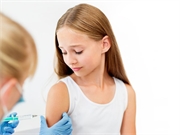MONDAY, Sept. 14, 2020 (HealthDay News) — More U.S. kids are getting a recommended vaccine that protects against several cancers — but there is still much room for improvement, a new study finds.
At issue is the vaccine against human papillomavirus (HPV). Certain strains of HPV are sexually transmitted, and some of those are “high risk” — meaning that if the immune system does not clear the infection, it can eventually lead to cancer.
In the United States, almost all cases of cervical cancer are caused by persistent HPV infection, according to the U.S. Centers for Disease Control and Prevention. The virus can also lead to cancers of the vagina, penis, anus or throat.
Since 2006, the CDC and other groups have recommended that all girls receive the HPV vaccine, starting at age 11, and that older girls and young women up to age 26 receive “catch-up” shots if they missed the earlier window. The advice was later extended to boys and young men.
Yet studies since then have consistently shown that most young people are not being vaccinated.
The new findings, published online Sept. 14 in Pediatrics, show that progress has been made.
In 2017, more than half of 15-year-olds had received at least one dose of the HPV vaccine. That was a significant gain from 2011, when 38% of girls and just 5% of boys had been vaccinated.
But the rates are still far short of the national goal.
“We’re doing better, but we have a long way to go,” said Dr. Amanda Dempsey, a professor of pediatrics at Children’s Hospital Colorado and the University of Colorado Denver.
Over the years, there have been a few reasons why parents and young adults skip the HPV vaccine, said Dempsey, who wrote an editorial published with the new study.
Some people worry about safety — in part because they think the vaccine is “too new,” she said.
Those concerns are diminishing now that the vaccine has been used for 14 years, Dempsey said. But another obstacle is that many people do not believe they — or their child — are at risk of HPV.
“I think we still struggle with addressing perceived risk,” Dempsey said.
That’s despite the fact that HPV is the most common sexually transmitted disease. It’s so common, the CDC says, that nearly all sexually active men and women will contract the virus at some point, unless they are vaccinated as children.
Only a small portion of infections become persistent and lead to cancer. But each year, HPV causes about 35,000 cases of cancer nationwide, the CDC estimates.
According to Dr. Ina Park, “The HPV vaccine is highly effective and can prevent multiple cancers.” Park is an adviser to the American Sexual Health Association and associate professor at the University of California, San Francisco School of Medicine.
Preteens get other vaccinations at high rates, noted Park, who was not involved in the study. Those include shots against meningococcal disease and tetanus, diphtheria and whooping cough (Tdap).
But those vaccinations are often required for school, while few U.S. states have school policies regarding the HPV vaccine.
Beyond that, Park said some doctors may not strongly recommend HPV vaccination to parents — or do not “bundle it” with the other immunizations preteens get.
The current findings are based on health insurance records for more than 7.8 million U.S. children, for the years 2003 to 2017. By the final year, 57% of 15-year-old girls had received at least one dose of the HPV vaccine, as had 51% of boys.
However, patterns varied widely among states, according to the report by Dr. Szu-Ta Chen, of the Harvard T.H. Chan School of Public Health in Boston, and colleagues.
In 2017, eight in 10 girls in Washington, D.C., had received at least two doses of the HPV vaccine. (Two or three doses are recommended.) Meanwhile, that was true for only 15% of boys in Mississippi.
Why is unknown. But there were signs that state policies had an impact. Vaccination rates tended to be higher in states with legislation to “improve HPV education.”
Park said she does believe that education for doctors — from public health authorities, rather than industry — is helpful.
More information
The American Sexual Health Association has more on HPV.
Copyright © 2024 HealthDay. All rights reserved.

